|
The Fw 190 was conceived at the end of the 30s to substitute for the first generation of monoplane flankers (Me 190). Designed with avant garde concepts, this flanker gave rise to more than forty versions if we take into account types and subtypes. As the forefather of the Dora and the TA, it is undoubtedly one of the most prolific designs of its times. The 190A in particular is one of the most recognized versions among modelers worldwide. As a fighter, combat plane, interceptor and escort of jets, it had unique characteristics and a performance that made it famous far beyond the renown of some of its pilots.
The kit
This is a great moment for those who love the 1/72 scale since many of these models are becoming growingly available everyday. However, there is no such aftermarket variety for them and not all of the makers provide the desired version -A6 in this case- in particular.
|
I chose to follow a decal manufacturer's suggestion: the Hasegawa's kit. I am absolutely aware that taking a decal manufacturer's suggestion sometimes implies not using the most accurate model. Anyway, I decided not to be so perfectionist this time and to carry out my project with a view to achieving an acceptable final result.
The reason behind such a decision was that the several makers offer kits of different measures but the most acceptable one is Hasegawa's as far as adapting the decals is concerned.
I could check this for myself with the engine cowl checkered pattern; even though the scale of all brands should be the same, their measure differs from kit to kit, including the diameter of the engine cowl.
|

|
|
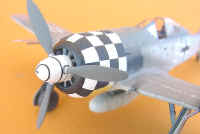
|
Things such as this should particularly be taken into account by fresh modelers since the risk of choosing a brand different from the suggested one may lead to countless difficulties, which sometimes may be impossible to surmount, quite much as in this case. Anyway, the kit is one of the best in the market, and it allows us to achieve a good model in a comparatively short time.
Assembly and detailing
|
I could get hold of only two PE sets for the Fw190, one of Eduard Zoom's, specifically designed to build an A8 R11, and the other one, of Eduard's for the Dora-9. I chose Eduard's because it was the only one to suit my needs.
Once the cockpit was built with the PE, I placed the only part from another kit: the seat. I took it from the Revell kit since it is much better than the original one. Once the inside was painted following colour pictures and drawings, I kept on building the model according to the instructions, which are comparatively simple.
It is easy to detach the flaps and the landing gear articulations and to remove the instrument panel cover thanks to the quality of the plastic, which is neither hard nor brittle.
With respect to the flaps, the PE instructions indicate to dispose of the plastic part and use only the metal one. I chose to use both of them together since it looked more real that way, according to the pictures where the structure was shown.
The main landing gear brake system's tubes were done with copper wire, and so was the small antenna on the rear part of the belly.
The antenna on the back was done by passing "hair" through the cockpit through a very small hole made with a 0.2 mm. drill. Finally, the cannons and the pitot tubes were made with syringe needles.
|
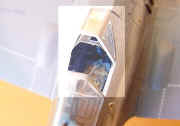
|
|
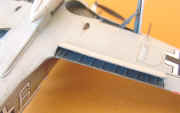
|
|
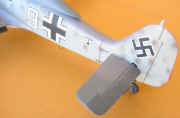
|
|
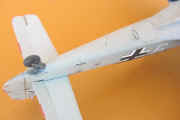
|
|
Though here we have a short list of improvements, it is important to pay attention to them since they will allow the performance of a good work which will not be so time-consuming. This is excellent particularly for those who are new to the model detailing activity.
|
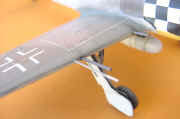
|
Decoration
For the decoration I used one of the several versions of the Eagle Strike # 72027 decal sheets, after checking the accuracy with the available bibliography. The sheet indicates the pilot's name and the unit. In this case, I was able to check only the checkered pattern used in those days and for that unit in particular.
The cockpit interior was painted with Model Master RLM 66; details were made with inks of different colours, based on the different colour pictures I had found.
The wheel wells were painted with Humbrol RLM 02 and were detailed with sienna ink washings, brightened with the base colour mixed with some white paint.
The external part was painted with Model Master RLM 74 and 75 and Life Color RLM 76. Humbrol was used for the RLM 04 colours, the white of the engine cowl and the propeller cone and the RLM 70 of the spools. For the engine ventilation panel, Model Master Gunmetal was used. Both varnishes were Model Master and were applied with an aerograph, as the rest of the colours were.
Once again, the painting stage is critical since it is necessary to perform it in different steps to achieve the difference between the coloured areas with hard edges (yellow panel of the engine cowl, white areas and ventilation panels) and the rest of scheme, which requires painting by hand with an aerograph as thin as possible (this may be achieved by placing the aerograph needle as forward as possible).
The decal sheet comes with all the basic trademarks that the aircraft has, as well as the national emblems and stencils. The quality is good and extra care need only be exercised in the cowl area so as to adapt the checkered pattern while the decal "stretches" and the liquids (Microsol and Microset), are working on it. Finally, I highlighted the lines bordering the fuselage panels very softly with sepia ink. The exhaust and cannon fume stains were done with an aerograph with diluted matt black.
Bibliography
 ""Fw190 in Action - Squadron/signal publications" Nš 19. ""Fw190 in Action - Squadron/signal publications" Nš 19.
 "Fw 190 A/F Walk Around - Squadron/signal publications" Nš 22. "Fw 190 A/F Walk Around - Squadron/signal publications" Nš 22.
 "Fw 190 A/F/G - Colortech Nš1 - Cutting Edge". "Fw 190 A/F/G - Colortech Nš1 - Cutting Edge".
 "Warplanes of the Luftwaffe" World Air Power Journal. "Warplanes of the Luftwaffe" World Air Power Journal.
 "Wings of the Luftwaffe-Fw 190" The Discovery Channel "Wings of the Luftwaffe-Fw 190" The Discovery Channel
|